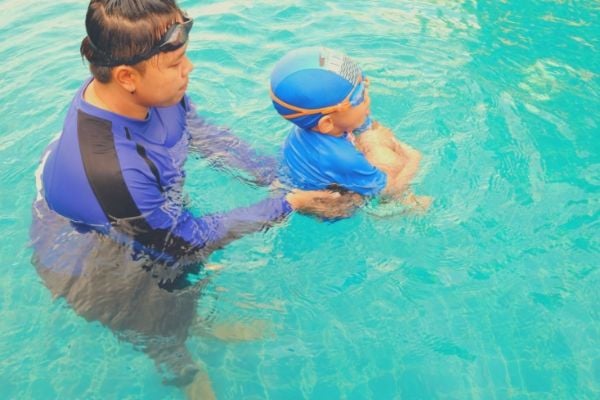We've introduced you to several key swimming skills and tips to help your child become a competent and confident safer swimmer. We’ve talked about your roadmap to success and how to work through building comfort, forward propulsion and breath control. We hope you find these tips helpful in developing your child into a confident, safer swimmer.Children who master the FUNdamentals and become safer swimmers are able to navigate social situations like pool parties, beach vacations, and even P.E. classes.
Let’s go over some of the key things you should be teaching your children to improve their water skills and become safer swimmers! If you have been with us since the beginning, this post will serve as a review with some added tips and advice. If you joined us midway through the series, you can go back to previous posts through the links we are including throughout.
Adult Supervision & Awareness
Children need to be supervised in the water. Even competent swimmers should be watched closely by their parents, caregivers, or a lifeguard. Children should be trained from a very early age that they should never attempt to swim alone, whereas parents and caregivers should learn to be active watchers of their kids in the water. There is no substitution for adult supervision! Accidents happen to even the best swimmers, kids always need a water watcher.
The first steps to safer swimming, then, are not about a child’s skills, the number of swimming lessons they’ve completed or the vest they’re wearing, but about adult willingness to stay vigilant and maintain supervision.
Appropriate Comfort with Water
As we discussed in our first lessons, children need to be comfortable in the water in order to become safer swimmers. Water discomfort can be caused by fear, sensory issues, uncertainty, pain, or a lack of trust between the child and the person teaching the lesson. Forcing a frightened child to swim before they are ready is a foolish task, because it can actually delay the process of becoming a good swimmer and can create negative associations with the water. Parents and swim instructors should be patient as they build water comfort. Watch for fear signals and respond to them with love, encouragement and support.
Breath Control
When your child develops comfort and confidence with facial submersion and breath control, the ability for safer swimming grows. Swimmers who can swim with their face in the water can swim further and longer while conserving energy. Kids who grow comfortable going underwater are often able to stay more relaxed that kids who cannot, which is a major aspect to staying safer in the water. This skill also really opens up the pool for maximum play opportunities!
Floating and Treading Water
We discussed both back floating and treading water in previous posts in this series. These two skills are related, because they allow a child to take a rest in a tiring situation. If a kid is “in over their head,” as the saying goes, they can tire themselves out trying to swim to safety. This is especially likely if the child is not sure where safety is located (the nearest adult, a lifeguard, a floatation device, the edge of the pool, etc).
Propulsion
When a child needs to get to safety, it is important they are able to swim forward to that safe spot. Getting from Point A to Point B in a pool or in open water is part of recreational and safety-based swimming. In our courses for young children, we teach two primary propulsion methods, kicking with the legs and paddling with the arms. When these are combined, even very young children are able to move around the pool and swimming safer from point A to point B.
Safe Floatation Support
Choosing the appropriate floatation support is not as simple as picking one off the wall in the sports and outdoors section at your local store. You’ll have many options available to you, each serves a different purpose. Puddle Jumpers and Water Wings are common sights on children at the pool, but they are very restrictive on the arms and prohibit proper coordination and movement pattern development.
We recommend the SwimWays Power Swimr training vest - we’re not affiliated with them, but have used their vests in over 500,000 swim lessons and believe in the product. These vests allow children to be supported by 9 floatation inserts on the front and back without any arm restriction. As a child gains confidence and skill moving around the pool, reduce the amount of floatation support they by removing 1-2 inserts at a time.
Are you ready to test your child’s swim skills?
There is still time to sign up for email reminders for this series! Our last post will go over the basic swim test skills so that you know what your child will be evaluated on when they take lessons here at the Swim Revolution! Do you have questions about our lessons, instructors, methods, or facilities? Give us a call at 404.354.1180! You can ask your questions, sign up for a class, or even schedule a free class to check out what we do here. We look forward to talking with you!





